This post contains affiliate links.
This is one couple’s DIY Tiny House in Ecuador! James is from Ireland and built the home with his Polish partner, Monika.
The two are in living tiny in Ireland right now after spending five and a half months on their Ecuadorian home. There’s more to do when they return, but in the meantime, enjoy James’ build story and our interview with him:
It was built from mid-September 2016 to mid-February 2017. It essentially started out as a truck trailer, these types of trailers are quite common in Ecuador. Once the trailer was purchased we essentially just built a little house around it.
Neither of us had really done anything like this before, and I have never worked in a trade or anything so it was quite an undertaking for us, especially in the quite short time we had available to us. We had to get some hired help for a few weeks to speed up the process, but we did a lot of the work ourselves, including the furniture and loft.
It’s quite basic compared to some of the Tiny Houses out there, but needless to say we are very proud of it. Unfortunately we had to leave Ecuador just as it was completed (a friend is living in it at the moment) but we plan to make it back in the near future.
We use Eucalyptus wood for most of the construction, with some Pine in the roof structure to keep the weight down. Bamboo was used on the inside of the roof, and the walls are insulated with foam and covered in wooden board. It’s quite spacious inside.
Also I like to think that someone who has never built something or perhaps doesn’t have building skills per se, could look at our house and say ‘Hey I could do that!’. We built the house for $6500.
The rest of the interview is below the picture tour of the home’s construction. Enjoy!
Related: Christine’s 16 x 32 Lofted Barn in AL: Her Story
One Couple’s $6,500 DIY Tiny House

Images via James McSherry

























Images via James McSherry
Related: Interview with Jadon and Katie: Good and Tiny House
Interview:
What are your name(s)?
James McSherry and Monika Dziatkiewicz
How many people (and animals) will are living in your tiny house?
At the moment a friend of ours is living there. We have moved back to Ireland at the end of February 2017.
Where do you live?
We currently live in Ireland. Our tiny house is located about 1hr 15 mins drive from Quito in Ecuador. It’s on a piece of land I bought next to the Rhiannon Permaculture Community in Ecuador.
Why did you decide to go tiny? What are you hoping to get out of living tiny?
I have come to love the simplicity of smaller spaces. They make a lot of sense to me, financially and from a lifestyle perspective. Living in a small space forces you to appraise exactly what you need to live. There’s no room for a load of stuff you don’t really need. I am interested in simple living and have been slowly ‘downsizing’ in different ways over the last few years.
How did you first learn about tiny houses?
The process of going ‘tiny’ probably began when we lived in a small bungalow in Dublin. I have often lived in smaller spaces, when travelling and at home. A friend of mine is an architect who specializes in the construction of smaller, low impact houses. I worked with him a bit at his place in the West of Ireland site and understood that the tiny house movement is really a reflection of an approach to life, the tiny house is really a product of this approach to life. His two ‘Sheltermaker Manuals‘ are a fantastic resource on this front.
How long did it take to finish your tiny house?
Five and a half months.
How did you find a place to park and live in your tiny house?
I own the land. While the house started out as a trailer, it’s not going to be moving anywhere now!
Before going tiny, what was life like?
Life felt a lot more cluttered. We are about to move into a small apartment in Ireland and I am in the process of clearing out most of my possessions at home. When we lived in Ecuador building the house, we also lived close by in another tiny house at the Rhiannon Community.
What benefits are you experiencing after going tiny?
I think we are on the path to potential financial freedom in the future, life feels less cluttered, and genuinely feel that there’s more time and energy to focus on living, rather than stuff. For me, its hard to overstate the feeling of freedom that comes with moving onto this track. It’s not something that happens overnight, I probably started consciously downsizing about 5 years ago.
What about some challenges?
Our house in Ecuador is basic. We only had running water, but no other services. We bought an electricity generator during the build for power tools.
It can be a bit challenging opting for a more downsized life when the message we so often hear runs contrary to this. Friends and family etc. might find it an unusual to being with. I think the reality of the need for smaller housing options, as well the benefits make tiny houses a real alternative to more mainstream options.
What makes your tiny house special?
The view from our porch! It’s pretty spectacular. Like anything you make yourself, I think you’re pretty proud of anything you build yourself. We had to work with logs of eucalyptus, which had to be debarked in some cases. I think the framing work we did is attractive, in a rough and ready sort of way. It’s damn hard wood and takes quite a bit of work.
What is your favorite part of your tiny house?
The loft bedroom part I built. It took time and patience and was the first time I had attempted something like that, so was happy with the result.
What, if anything, would you change about your tiny house now that you’ve lived in it?
To be honest, there’s so much more we wanted to do, but didn’t have the time this time around. I cant think of much we would change, perhaps installing a stove would be a great next step and something I would have love to have implemented if we had the chance. There’s still lots of work to be done on the outside, including finishing off the porch. That will come in time.
What helpful advice would you give to others interested in going tiny?
Try it out first, and get some practise at living in a downsized fashion. Sell lot of stuff! Have a go at building yourself if you are in a position to do so. Building the home was one of the most rewarding things I have ever done.
Check out James’ Blog here, and learn about how much it cost to build the house here.
Resources:
- James’ Blog: Occam’s Last Razor
Share this with your friends/family using the e-mail/social re-share buttons below. Thanks!
If you liked this you’ll LOVE our Free Daily Tiny House Newsletter with more! Thank you!
More Like This: Explore our Tiny Houses Section
See The Latest: Go Back Home to See Our Latest Tiny Houses
This post contains affiliate links.
Natalie C. McKee
Latest posts by Natalie C. McKee (see all)
- Turning an Old Shed into Her Tiny Home - April 26, 2024
- 865 sq. ft. Michigan Cottage - April 26, 2024
- Urban Payette Tiny House with Fold Down Deck! - April 25, 2024






Another example what can be done on a tight budget.
When there is a will there is a way to do it.
Thanks Michael, I appreciate your words. Our budget was small, but we will be back for the next phase. We will add as we can, when we can!
Way to go, excellent initiative with the minimum.
Thanks Claude!
Looks like paradise!
Thanks Wendy. Yes, we love it. Although some days it can feel like you are about to be blown off the edge 🙂
Love tiny. Looks to be a practical home. That counts a long way toward being a good life.
I agree!
Hi guys.
I absolutely love the concept of the tiny house and I also love your back yard! It is gorgeous! Congratulations and if you allow it, I would love to stop by and see it someday!
Hi Micky,
Sure, if you are ever in the neighbourhood you are more than welcome 🙂 You can contact me on my site listed above!
While I applaud the effort to live tiny and through one’s own industry, and certainly am impressed with the DIY-ers in this movement, I think something must be said about littering developing countries with experimental structures that become blights on the landscape from which after a couple years, the privileged move on. You mention the views but now this crude eyesore has been set down in the middle of someone’s ocean scape. Perhaps planting flowering vines that can overgrow the house will soften the look, and it will age well? Nevertheless, if governments are going to accept tinies as normal and a fact of life, it makes sense for the pioneers to consider the exterior aspect/impact of the home on countrysides and neighborhoods.
Two cents. I know, I know: beauty is in the eye of the beholder.
Annette, this is in fact my house. While I respect your entitlement to your own opinion, you are criticizing from a position of little knowledge of a) the site itself b) the area it was built c) our possession (or lack of) ‘privilege’ and d) apparently the article itself. I would like to clarify a point or two.
We are blocking nobody else’s view of anything. There is no ocean, we are in the mountains. We are in the middle of countryside, on a steep hill. Nobody shares direct line of sight view with us. Ecuador is a developing country, with a strong DIY ethos. A lot of people build their own homes. It’s normal. Our Ecuadorian neighbours helped us build it.
As mentioned in the article, the house is not finished and we intend on doing further work on it (including painting, landscaping etc). In fact it’s probably only about 1/2 completed.
We will also be returning, as we have strong feelings for, and connections in, Ecuador. The house is actively being lived in and used.
As you acknowledge, beauty is in the eye of the beholder, and I think it is beautiful. Many locals loved the idea of reusing a truck container that would otherwise be thrown out. I do too.
It’s easy to criticize from your keyboard when you no nothing about our circumstances or ‘privilege’.
Tinies and other scaled-down living models will accepted by governments as sensible and practical solution to many of the housing crises taking place in nations across the globe. This will neither rest nor fall on the hand-built creations of ‘pioneers’, as you so gracefully call us.
James, thanks for reminding me of my many limitations. Of course you are right – I know nothing about your site nor circumstances, except to say that apparently the sky there is as wide as an ocean, from the pix.
I do not separate myself from the tiny movement, having downsized in 2011. Your “us” is a “we.” While my 450 square feet is twice the size of many tinies, it is a fraction of what I had been used to, a radical change & challenge.
I share environmental values with the tiny house community and am making my best attempt to reduce my carbon footprint.
I’m much interested in re-use and experimental architectures. I love the creativity, energy, and initiative of the ideas encapsulated by people trying to live without debt, reasonably; those trying to create a new standard of living using imagination – such as yourself, perhaps?
Along the lines of living on a shared planet, my general point is that homes create a neighborhood, and the character of those homes impact each other, and impact real estate values.
It’s seriously questionable to me whether foreign/non-indigenous people have the right to move into countries where it’s possible to build experimental structures with little to minimum oversight, or where codes are lax and non-existent, because costs are far less.
As you say I do not know whether Ecuador is in this category, but it seems to me that the relative costs of building there play a major role. I could be wrong. But as with building anywhere, there’s an obligation to add real value, not create some kind of retro hillbilly situation with old truck bodies and car parts scattered across the yard.
You have cautioned me that the project is not finished and I wish you good luck. Naturally I hope you will look to your proportions before inflicting any more constructions onto the property.
Let me say when I showed this article to my son, an accomplished professional artist whose opinion I deeply respect, he loved it.
Meantime neighbors and not just structures create a neighborhood. It sounds like you’ve got some great relationships going on, which is the more important human element in any case.
Peace out.
Hi Annette,
Thanks for taking the time on my responses and writing a considered response.
Firstly, congrats on downsizing, it is a radical change and challenge. I am curently selling many things at home to make way for living in a small apartment. I’m enjoying the process and am sure the journey is worth it.
I am very much on board with trying to live without debt, as I believe it can be one of the greatest drains on emotional and creative wealth there is. Our decision to build in Ecuador has been a 4 year journey at this stage, most of the costs existed outside the building of the house itself (quitting jobs, purchasing the land etc). It’s been a significant investment on many fronts, not simply the sticker-price $ headline.
Building regulations are quite lax in Ecuador, but like many developing countries, they are lax across the board. While this can facilitate creativity, it can lead to many problems too, some along the lines you mention. For our part, we have no intention of creating rust-gardens of abandoned machinery. Trees trees and more trees is the plan.
On a side note, in my experience I have found that in developing countries where things are less planned, less organised, and more chaotic these conditions seem to foster a vibrant sense of community often missing in developed countries where estates become more like collections of mini-castles.
As you might expect, I don’t think we have inflicted anything on the area.
You note it is people and not just structures that create a neighbourhood. Our little house is not out of character with neighbours’ houses, many of which are extremely basic. I consider it almost entirely people that make the neighbourhood.
Good luck with your downsizing journey – one thing’s for sure, it doesn’t happen overnight.
What a lovely house! The surrounding countryside, the use of materials, the tiny saplings around the house all feel so right. It would be enlightening to see how you supply water in future (cachement system with well?) or whether you utilize the wind or sun for energy. I hope that you return to Ecuador, soon. Much luck to you both!
Hi Lorraine,
Thank you so much! There are plans to bring in an irrigation scheme to the area from local mountain lakes, so that will greatly help with potential irrigation as the area is very dry. At present we have a water supply connected, but it is not used for irrigation, only domestic use as there are controls in place over how water can be used. Definitely plan to use solar panels for electricity in the future but not there yet!
This is great what the two of you are doing!. You have built your own home on your own land, living the simple good life. This is my goal exactly, simple eating included, which I already do 🙂 I am going to check out your blog soon!
Sharon,
Yes exactly. This simple living and TinyHouse thing just keeps going. More than anything it’s become a way of appraising life decisions, and a deliberate avoidance of over-complicating things. Would love to hear from you over on the blog too 🙂